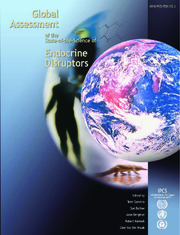2002 Global Assessment of the State-of-the-Science of Endocrine Disruptors report published by the joint International Programme on Chemical Safety (IPCS) of the World Health Organization (WHO), the United Nations Environment Programme (UNEP), and the International Labour Organisation (ILO).
Fetal basis of adult disease: Role of the environment program by NIEHS funded grants and jump-started research on developmental programming and EDCs.
NIEHS Conference on EDCs and Thyroid Function
Watch Day 2: Thyroid Hormone and Brain Development: Translating Molecular Mechanisms to Population Risk.
The Hormone Disruption Research Act of 2002, a bill to authorize the National Institute of Environmental Health Sciences (NIEHS) to conduct and coordinate a research program on hormone disrupting chemicals, was introduced to the US House of Representatives.
Dr. Tyrone Hayes found low dose effects of the pesticide atrazine on frogs:
Hayes TB, Collins A, Lee M, Mendoza M, Noriega N, Stuart AA, Vonk A. Hermaphroditic, demasculinized frogs after exposure to the herbicide atrazine at low ecologically relevant doses. Proc Natl Acad Sci U S A. 2002 Apr 16;99(8):5476-80.
Multigenerational effects: DES was shown to affect a third generation in humans:
Klip H, Verloop J, van Gool JD, Koster ME, Burger CW, van Leeuwen FE; OMEGA Project Group. Hypospadias in sons of women exposed to diethylstilbestrol in utero: a cohort study. Lancet. 2002 Mar 30;359(9312):1102-7.
Science Communication Network founded by Dr. Pete Myers and Amy Kostant.
Environmental Health News and Environmental Health Sciences founded by Dr. Pete Myers.

